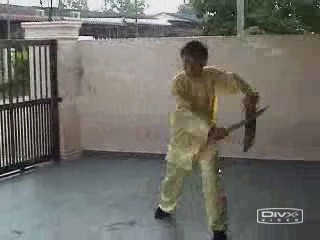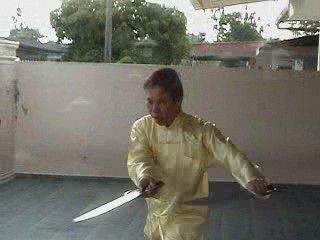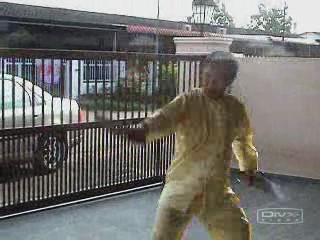CHAPTER 9 -- WING CHOON WEAPONS

"Jen-formation" of "Human-Character Butterfly Knives"
The two best known classical Wing Choon weapons are butterfly knives and single-headed staff. In Choe Family Wing Choon, the style of Wing Choon Kungfu I practice and which I learned from the Wing Choon patriarch, Sifu Choe Hoong Choy, the two weapon sets are "Human-Character Butterfly Knives" and "Six-and-Half-Point Staff". In Cantonese Chinese, the language that Sifu Choe Hoong Choy and I used, they are respectively called "Jen Tze Tou" and "Luk Tim Pun Khuen".
The "Human-Character Butterfly Knives" is so named because in some characteristic patterns the knives are held together forming the Chinese character "human". The "Six-and-Half-Point Staff" is so named because the staff set is composed of only six and a half points or techniques. Why is there only half a techique, and not one technique? As it is a close secret told to me by the Wing Choon patriarch, Sifu Choe Hoong Choy, I shall not mention it here.
In the popular style of Wing Choon today, which comes from the lineage of Sifu Yip Man of Hong Kong, the weapon set for butterfly knives is called "Eight-Chop Butterfly Knives". The weapon set for the single-headed staff is also Six-and-Half-Point Staff", though there are some slight differences in the staff techniques between Sifu Choe Hoong Choy's school and Sifu Yip Man's school. In Cantonese Chinese, they are respectively called "Pat Cham Tou" and "Luk Tim Pun Khuen".
In Sifu Choe Hoong Choy's Wing Choon school, other weapons, like the single knife, the spear, the Guan Dao (or the halberd), the kungfu bench, the soft whip, the big trident, are also taught. The big trident, for instance, was highly regarded in Sifu Choe Hoong Choy's home district.

Soft-whip
The butterfly knives and the Six-and-Half-Point Staff were not originally passed down by the founder, Yim Wing Choon, herself. An interesting facet of their historical development is manifested in the different stances of the fundamental sets of unarmed Wing Choon Kungfu and in these weapon sets. The goat-riding stance and the four-six stance are the characteristic stances in the fundamenrtal Wing Choon unarmed sets, but these stances are generally absent in the weapon sets, where the prominent stances are the horse-riding, the bow-arrow, and the false-leg stances. But despite this difference in form, as is evident in the different stances and other movements, the underlying principles as well as applications of the butterfly knives and the Six-and-Half-Point Staff are typically Wing Choon in nature.
The Six-and-Half-Point Staff was devised by the great Shaolin grandmaster, the Venerable Chee Seen. When the Shaolin Monastery was burnt, Chee Seen escaped to Kwangtung Province and disguised himself as an odd-job worker in a showboat. There he taught the staff set to Leong Yi Tai. Because the showboat was limited in space, Chee Seen selected from the extensive and elaborate Shaolin staff techniques, only six and a half simple movements that he considered the best, and incorporated them into the now famous Six-and-Half-Point Staff. Later while Leong Yi Tai learned Wing Choon Kungfu from Leong Pok Khow, he in turn taught his teacher and friend this staff set.
The butterfly knives, according to popular belief, was included into Wing Choon repertoire when a Shaolin disciple exchanged this butterfly knives set with a Wing Choon master for the Six-and-Half-Point Staff set. This Shaolin disciple traveled widely in South China to match his skill in using the butterfly knives with other reputable kungfu experts. One night he saw a kungfu master practicing the Six-and-Half-Point Staff. The Shaolin master found the staff techniques simple and prosaic in appearance, but the movements very fluid and baffling. He asked the Wing Choon master for a friendly sparring. Both experts were greatly impressed with the skill of the other, and they finally agreed to teach each other the art of their respective weapons. Unfortunately I cannot trace the name of these two experts, nor the names of the sets.
Butterfly knives are southern weapons, popularly used in South China but rarely used in the north. They are, therefore, sometimes known as southern knives. Hence, the butterfly knives of Sifu Choe Hoong Choy is known as "Human-Character Double Southern Knives", or in Cantonese pronounciation it is called "Jen Tze Seong Nam Tou".
Like the winds of a butterfly, butterfly knives are usually in pairs. The exception is when a butterfly knife is used in conjunction with another weapon, like a rattan shield or a soft whip.
I know two weapon sets of the butterfly knives or southern knives, the "Human-Character Double Southern Knives" from Sifu Choe Hoong Choy, and the "Crossroads Double Southern Knives" from my first kungfu sifu, Uncle Righteousness, which I learned earlier. There is a big difference between the two sets which many kungfu practitioners may not know. In Uncle Righteousness' set, the southern knives are used in pairs, and the knives attack an opponent together. In Sifu Choe Hoong Choy's set, the southern knives attack an opponent one immediately after another.

In Uncle Rightousness' school the southern knives attack an opponent together
I pose at a typical poise-pattern of the butterfly knives while studying an opponent holding a spear. As he thrusts his spear at me, I move diagonally forward to a bow-arrow stance and simultaneously counter-attack with a reverse-slash to his front arm.
The opponent retreats his front leg and pulls back his spear to avoid my reverse-slash. Immediately he thrusts at me again. I move my body to my left and simultaneously wards off with my left butterfly knife to my right side, circle my right arm round the shaft of the spear, and immedately move forward into a left bow-arrow stance with a left reverse-slash.
The spear-thrust is technically the most dangerous technique to defend against. Thus, anyone learning a kungfu weapon cannot be considered competent in its application until he can defend and counter-attack a spear-thrust efficiently. For this reason, the spear is sometimes called "the king of weapons". On the other hand, the reverse-slash is considered a formiable technique of a bladed weapon, like a pair of butterfly knives and a sabre.
The weapon combat here involves the butterfly knives and the staff. The staff is sometimes called "the instructor of weapons", most of the techniques used in other weapons can be found in the staff. Thus, an exponent who is familiar with staff techniques and can defend himself successfully against staff attacks, will have some trasnfered knowledge about the techniques of other weapons, so that he can defend himself against these weapons even though he may not have any sparring practice with these other weapons previously. In other words, by learning combative techniques against the staff, one also learns valuable information that can be applied to almost all other weapons.
There are two major types of staffs, namely single-headed staffs and double-headed staffs. The single-headed staff is so called because normally only one end of the staff is used for combat, whereas both ends of the double-headed staff are used. The single-headed staff is normally longer than the double-headed staff, and it is therefore called the long staff, while the double-headed staff is called the short staff. The short staff is actually not short, averaging about six feet, with both ends usually of the same diameter. The long staff is about eight feet in length, and is usually tapering towards the combat-end.
There are some other weapons belonging to the staff family, such as double little staffs, two-sectional staffs and three-sectional staffs. The double little staffs are small sticks of about a foot long held in each hand. The two-sectional staff consists of two small sticks each about a foot long joint together by a short metal chain. It is popularly known to Westerners by its Japanese pronunciation, "Nanchaku". The three-sectional staff is a very versatile weapon, made up of three sticks each about one and a half feet long joint together by metal chains.
In the weapon combat sequence, my opponent uses a double-headed staff, and we study each other in our poise-patterns. My opponent moves forward with a horizontal sweep, with his right hand in front and the sweep coming on my left side. I block with a "jen-formation". The "jen-formation", so called because "jen" refers to the Chinese character meaning "human", is similar to the scissors-formation in unarmed Wing Choon Kungfu. After I have blocked the sweeping attack, I have a choice of many possible counter-attacks. I can chop, hew, sweep or reverse-slash the oppoent. From the technical point, the most suitable counter-attack in this particular situation is piercing him with the thrust-technique.
I can use the thrust-technique directly, without first blocking the horizontal sweep with the "jen-formation". This is the principle of "straight against circular". One may, therefore, wonder why is this seemingly redundant "jen-formation" used. There are two good reasons.
Firstly, if the opponent is very fast in his sweeping attack, I may need to block his attack before counter-attacking. The circular sweep, because of greater distance travelled, is technically slower than a straight thrust. But if the opponent is skillfully faster, he can take less time to execute the sweep than I take to execute the thrust, although the actual distance travelled by his sweep is greater. Because of this, beginners normally find it safer to block first, then counter-attack.
Secondly, if the opponent is very versatile, i.e. he can modify his patterns or movements speedily and flowingly at will, the "jen-formation" in blocking is useful. For example, as his horizontal sweep is only half-way in execution, he notices my straight thrust approaching him. He can discontinue his sweep smoothly and instantaneously, move his back right leg forward to the right bow-arrow stance and simultaneously use the other end of the staff to strike my lower vital organs. Such fast, unexpected counter-attack is generally deadly effective.

In Sifu Choe Hoong Choy's school the southern knives attack an opponent one immediately after another
Against a versatile opponent, it is advisable to use the "jen-formation" to block his initial attack. Not only is this tactic safer, but more professionally, it enables the exponent to "sense" his opponent's movements. The "jen-formation" of the butterfly knives in contact with the opponent's weapon resembles Sticking Hands in unarmed combat. After I have blocked the opponent's sweeping attack, instead of counter-attacking him immediately, I can place my knives in contact with his staff to sense his next moves. Because the opponent is versatile, I prefer to have him make the initial moves so that I can counter move accordingly. Generally, the combatant making the initial move has a disadvantage.
This "jen-formation" is a unique feature of Wing Choon butterfly knives. It is different from the ordinary scissor-like formation of butterfly knives in other styles of kungfu.
The Six-and-Half-Point Staff is highly esteemed not only by Wing Choon disciples but also by exponents of other styles. It is one of the four most famous sets in kungfu, the other three being the "Fifth Brother Pakua Staff", the "Ho Family Flowing Water Staff" and the "Left Hand Fisherman Staff".
This staff set is as simple in its appearance as it is fascinating and baffling in its combative application. Although many martial artists desire to learn this staff set, those who know the set and its application are few, and those prepared to teach the set and its application are rarer still. This reservation in teaching the staff set is not because of selfishness, but because of responsibility in passing this treasured art to the deserving. It has become the tradition of Wing Choon masters to teach the Six-and-Half-Point Staff only to selected disciples at the final stage. No exponent, therefore, can rightly be considered a Wing Choon expert until he has mastered this Six-and-Half-Point Staff.
The kind of staff normally used for the Six-and-Half-Point Staff set is the single-headed long staff of about eight feet. The staff is tapering and only the tapering end is used. There are about seventy two patterns in this staff set, and all the patterns consist of only seven techniqies, the last is considered half a technique. They are "spear", "hit", "throw", "flick", "circle", "dot", and "shelter".
Although there are only six and a half techniques, those who have mastered them and their myriad variations will find these techniques adequate for any combative situalions! Indeed, a master of the Six-and-Half-Point Staff is so skillful that he can defeat his opponent as soon as he makes a move. Herein lies the fascination of the set.
I use a seemingly prosaic poise to study my opponent with a spear. This poise pattern is actually as subtle as it appears simple. From his position I can move to execute any one of the six and a half technique with equal ease. As the opponent thrusts his spear at me, I spring to my right side and "hit" him on his head.
He moves his back right leg to his right side, retreats his front left leg, and simultaneously flick aside my staff. Following his flicking movment, I circle my staff under and around his spear, and strike him with the "dot" technique.
To master this Six-and-Half-Point Staff one must be able not only to execute its applications flawlessly and flowingly, but also to channel his force to the tip of the staff, as well as to use the staff, like his limbs, to sense the opponent's intentions. The staff becomes not just a weapon, but an extended part of the master, with the staff and the master functioning as one unit.
Grandmaster Wong Kiew Kit,
18th July 2019.

The "spear" technique of Six-and-Half-Point Staff
LINKS
Introduction to Wing Choon Kungfu
Courses and Classes





